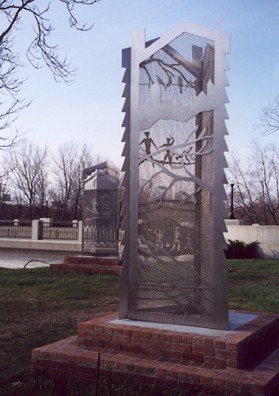|
PUBLIC
ART HELPS STRENGTHEN COLUMBUS COMMUNITY

Side
by Side by
Charlotte Lees adorns the Harrison West
Neighborhood of Columbus
and
reflects the history of the area.
The historic district of Harrison West in Columbus, with residents of
diverse backgrounds, has experienced racial tension and neglect over the
years. The Harrison West Society was established in 1975 to work toward
urban renewal and the improved quality of life for its residents. Now,
public art on a small parcel of land is uniting residents in this diverse,
inner city neighborhood. The land was turned over to the Columbus Recreation
and Parks Department after a developer¹s plans to build condominiums
were thwarted. Harrison West Society member Maddy Weisz proposed commissioning
sculpture to create a positive identity for the neighborhood.
The
grassroots, community-oriented project was embraced by Harrison West residents
who participated in the fundraising for and installation of the piece.
With support from the OAC, the Harrison West Public Art Committee opened
a design competition resulting in 22 proposals. At a well-attended community
voting event, residents chose Side by Side, a sculpture created by OAC
Individual Artist fellowship recipient Charlotte Lees.
The sculpture consists of two 10 foot stainless steel towers featuring
motifs that represent the neighborhood. The images of Victorian architecture
and children at play speak to the history of the area while alluding to
the neighborhood's potential.
The project inspired community members to found the BrickStreet Arts Association
to promote similar projects in other Columbus neighborhoods. The BrickStreet
Arts Association is partnering with the Short North Neighborhood Foundation
and the Special Improvement District to create public art for pocket parks
amongst the buildings lining High Street. The projects will continue to
empower community members and create neighborhood pride.
|
|
OHIO,
THE ARTS AND TECHNOLOGY
In
the past 50 years, technology has had a dramatic effect on every aspect
of American life, including the arts. Today, thanks to e-mail and the
Internet, artists connect and share with one another over great distances.
Teachers use computers to expose their students to art and music from
around the world. Artists with disabilities use a multitude of adaptive
devices to allow for greater creative freedom. The Ohio Arts Council strives
to keep abreast of the latest technological advancements, and uses technology
to make the arts more accessible, affordable and prevalent in all corners
of our state.
Expanded
technology has led to increased efficiency and productivity at the Ohio
Arts Council. OAC staff members can easily share files and resources with
their colleagues around the country with the touch of a button, spending
less time and tax money on postage and paper. E-mail facilitates communication
between the OAC¹s Columbus office and field offices in Cleveland
and southern Ohio.
The OAC also awards grants to Ohio organizations to improve their use
of technology. In 2001, the Foothills School of American Crafts in Nelsonville
used OAC funds to launch their website, which features a virtual gallery
of artists¹ work and provides international exposure for Appalachian
artists and culture.
Keeping up with the rapid pace of technological advancement is a challenge,
but bringing information services equipment up to date is a high priority
in the agency's new strategic plan. The OAC plans to develop an electronic
granting system to meet state mandates and better serve constituents.
In addition, the agency will evaluate and streamline all business practices
to stretch tax dollars. These efforts are in line with the state¹s
efforts to improve information services for Ohioans.
|
![]()